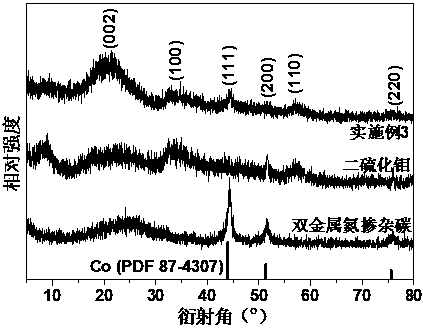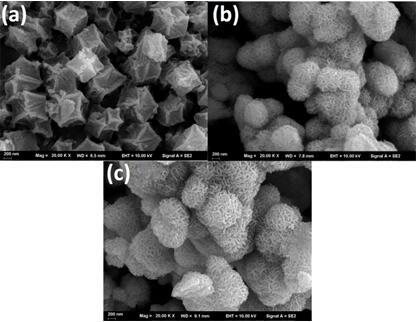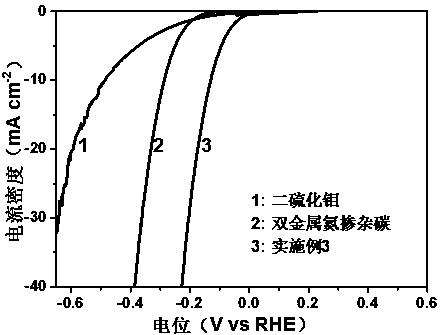Bimetallic nitrogen doped carbon/molybdenum disulfide composite electrocatalyst material, preparation method thereof and application thereof
A nitrogen-doped carbon and molybdenum disulfide technology, which is applied in the field of electrocatalytic hydrogen evolution, can solve the problems of reducing the number of catalytic active sites, limiting the ability of electron transfer, and serious aggregation of nanosheets, so as to improve the performance of electrocatalytic hydrogen evolution and enhance HER Active, uniform size effect
- Summary
- Abstract
- Description
- Claims
- Application Information
AI Technical Summary
Problems solved by technology
Method used
Image
Examples
Embodiment 1
[0025] Step 1) Preparation of metal-organic framework: Disperse 873 mg of cobalt nitrate in 30 mL of anhydrous methanol, disperse 985.2 mg of dimethylimidazole in 10 mL of anhydrous methanol, mix the above two solutions and stir at room temperature for 1 h. The solid was isolated and a metal-organic framework Co-MOF was prepared.
[0026] Step 2) The obtained Co-MOF powder was loaded into a porcelain boat, transferred to a temperature-programmed tube furnace, and under the protection of nitrogen, the o C / min heating up to 600 o C and held for 3 h; after natural cooling to room temperature, a black powder was obtained, which was cobalt metal-doped carbon (Co / NC).
[0027] Step 3) Preparation of cobalt metal-doped carbon / molybdenum disulfide composites by hydrothermal method: Dissolve 120 mg sodium molybdate tetrahydrate and 250 mg thiourea in 25 mL deionized water, pour the solution into a 50 mL reaction kettle, Then add 50 mg of the cobalt metal-doped carbon prepared in step...
Embodiment 2
[0029] Step 1) Preparation of metal-organic framework: 150 mg of zinc nitrate and 1365 mg of cobalt nitrate were dispersed in 30 mL of anhydrous methanol, 1980 mg of dimethylimidazole was dispersed in 10 mL of anhydrous methanol, and the above two solutions were mixed Stir at room temperature for 1 h, collect by centrifugation, and wash several times to prepare the bimetallic organic framework ZnCo-MOF-1.
[0030] Step 2) The obtained ZnCo-MOF-1 powder was loaded into a porcelain boat, transferred to a temperature-programmed tube furnace, and under the protection of nitrogen, the o C / min heating up to 700 o C and keep warm for 1 h. After natural cooling to room temperature, a black powder is obtained, which is bimetallic doped nitrogen carbon (ZnCo / NC-1).
[0031] Step 3) Preparation of bimetallic nitrogen-doped carbon / molybdenum disulfide composites by hydrothermal method: Dissolve 120 mg sodium molybdate tetrahydrate and 250 mg thiourea in 25 mL deionized water, and pour t...
Embodiment 3
[0033] Step 1) Preparation of metal-organic frameworks: 223.1 mg of zinc nitrate and 654.8 mg of cobalt nitrate were dispersed in 30 mL of anhydrous methanol, and 985.2 mg of dimethylimidazole was dispersed in 10 mL of anhydrous methanol. After mixing the above two solutions Stir at room temperature for 1 h, collect by centrifugation, and wash several times to obtain the bimetallic organic framework ZnCo-MOF-2.
[0034] Step 2) The obtained ZnCo-MOF-2 powder was loaded into a porcelain boat, transferred to a temperature-programmed tube furnace, and under the protection of nitrogen, the o C / min heating up to 700 o C and keep warm for 2 h. After natural cooling to room temperature, a black powder is obtained, which is bimetallic doped carbon (ZnCo / NC-2).
[0035]Step 3) Preparation of bimetallic doped carbon / molybdenum disulfide composites by hydrothermal method: Dissolve 120 mg sodium molybdate tetrahydrate and 250 mg thiourea in 25 mL deionized water, pour the solution into ...
PUM
 Login to View More
Login to View More Abstract
Description
Claims
Application Information
 Login to View More
Login to View More - R&D
- Intellectual Property
- Life Sciences
- Materials
- Tech Scout
- Unparalleled Data Quality
- Higher Quality Content
- 60% Fewer Hallucinations
Browse by: Latest US Patents, China's latest patents, Technical Efficacy Thesaurus, Application Domain, Technology Topic, Popular Technical Reports.
© 2025 PatSnap. All rights reserved.Legal|Privacy policy|Modern Slavery Act Transparency Statement|Sitemap|About US| Contact US: help@patsnap.com



